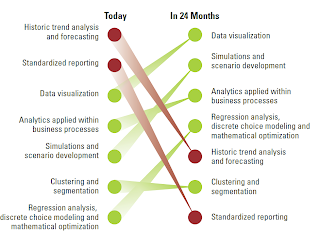With analytics technology spend increasingly being spread out to the "masses" (departments, even end users), how can you get projects off the ground? It seems to me:
- Start big, or start small, but don't start in the middle. Presenting a radical transformation can get you in the door with executives. From there, you might scale down to a piece of the puzzle that's practical to implement. Or, you can find a small, high-value problem with a defined solution for a quick win. From there expand into other advanced analytics areas (land and expand isn't dead). But going somewhere in between seems too complex for the return -- keep your big vision big, or your small project in scope until the deal is won.
- Know your customer. And I mean really know your customer, and everything they do. This is a little more than perusing the website and listing to the earnings calls. Understand their industry, culture, vision, and competitors. That business context is the only way to sell something this complex.
- Dig in for a long ride. These technologies aren't getting simpler. While there's potentially massive value to be had, it will take time, as will your sales cycles.
